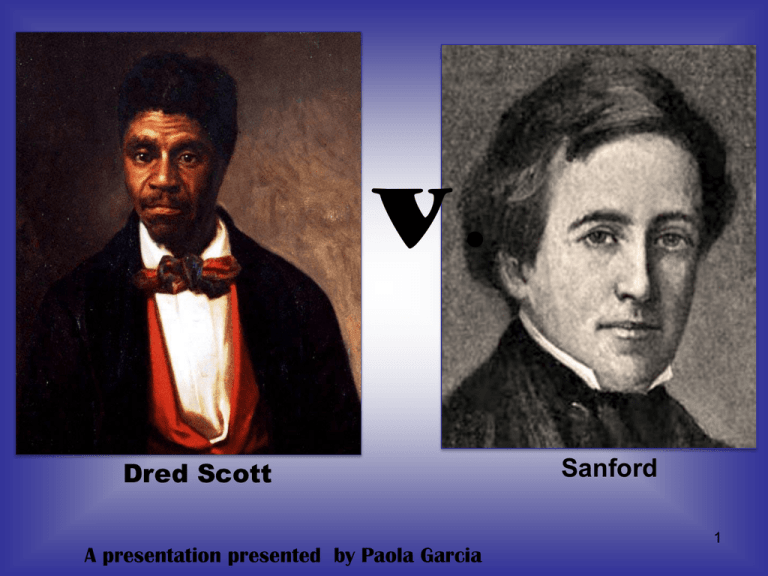Dred Scott v. Sanford Case Presentation: History & Supreme Court
advertisement

V. Dred Scott A presentation presented by Paola Garcia Sanford 1 History prior to the famous Dred Scott VS. Sanford case Scotts wife • Dred Scott was born a slave between 1795 and 1800 and in 1830 was taken by his owners to Missouri when a military surgeon, Major John Emerson, purchased him. • Over the next 12 years Emerson took Scott along to various forts where he was assigned. • He was first stationed at Fort Armstrong in Illinois where the Northwest Ordinance banned slavery. Then Emerson was stationed at Fort Snelling where the Missouri Compromise of 1820 had also banned slavery. • so at for Snelling Emerson allowed Dred to marry a slave named Harriet. 2 History continued… • In 1837 Dr. Emerson was ordered to Fort Jessup, Lousiana. There, he married Eliza Irene Sanford in 1838. •Emerson then sent for Dred Scott and his wife and on their way on a steam boat, their first child, Eliza was born on the Mississippi river between the Iowa Territory and Illinois. IT’S A GIRL!!! •In 1840, Emerson was serving in the Seminole war and returned to St. Louis in 1842 and returned to St. Louis in 1842 and later died in the Iowa territory in 1843 and his wife Eliza inherited everything of his including Dred Scott, his wife and their daughter. 3 First attempt to Sue: Dred Scott VS. Eliza Irene Emerson V. Eliza Irene Emerson • Scott sued Mrs. Emerson for "false imprisonment" in 1846 also claiming that Emerson held him illegally, and that he had become a free man as soon as he lived in a free territory or state and then was taken against his will to a slave territory or state. • His lawyers also fought for the freedom of his wife and daughter who was born between a free state and a free territory, therefore should be considered free too. •This first trial was then dismissed because Dred failed to present a witness say that John Emerson was his owner. •While this was going on, Dred and his wife had another child named Lizzie. 4 Dred Scott V. Eliza Irene Emerson contd……. • At the end of 1847, the judge granted Scott a new trial. • Mrs. Emerson agreed and the trial was scheduled but did not take place until 1850 due to the cholera epidemic. (eww) • The court found that Dred Scott and his family were legally free but Mrs. Emerson won. By that time though, she moved to Massachusetts and transferred the case to her brother John F, A Sanford. 5 Finally…… Dred Scott V. Sanford V. • By 1853, John Sanford was the owner of the Scotts. • Sanford had moved to New York and left Dred Scott and his family in Missouri. Since federal courts settle the dispute between citizens of different states, Scott was able to sue Sanford in federal court in a new case. Interesting fact: •A clerk mistakenly added a letter to Sanford's name, so the case permanently became Dred Scott v. John F. A. Sandford (haha funny) •At trial in 1854, the federal court directed the jury to rely on Missouri law to decide Scott's freedom. Since the Missouri Supreme Court had held Scott was a slave, the jury went towards Sanford’s side. Scott then appealed to the U.S. Supreme Court. 6 The CASE GOES SUPREME!!!!!!! • By the day of his inauguration, he knew what the outcome of the Supreme Court's decision would be and took the opportunity to throw his support to the Court in his inaugural address saying: • Before the supreme court made a decision, president-elect James Buchanan contacted some of his friends on the Supreme Court starting in early February asking if the Court had reached a decision in the case because he needed to know what he should say about the territorial issue in his inaugural address on March 4. “A difference of opinion has arisen in regard to the point of time when the people of a Territory shall decide this question [of slavery] for themselves. This is, happily, a matter of but little practical importance. Besides, it is a judicial question, which legitimately belongs to the Supreme Court of the United States, before whom it is now pending, and will, it is understood, be speedily and finally settled. To their decision, in common with all good citizens, I shall cheerfully submit, whatever this may be.” 7 Final decision • The Supreme Court ruling was handed down on March 6, 1857, just two days after Buchanan's inauguration. • The southern Supreme court justices decided to declare the Missouri compromise ban on slavery was unconstitutional but to avoid the appearance of a decision based on sectionalism they pressured northern democratic justice, Robert Grier of Pennsylvania to accept the decision. CHEATERS!!!! •But in total 6 justices agreed with the decision Final decision contd…. Chief justice Taney issued the Court’s ruling stating that congress lacked the power to keep slavery out of a territory because slaves were property and the constitution protects the right of property. He also wrote that the circuit courts should not have accepted the Scott case in the first place because black men were not citizens of The united States according to the creators of the constitution “beings of an inferior order, and altogether unfit to associate with the white race, either in social or political relations, and so far inferior that they had no rights which the white man was bound to respect." and therefore had no standing in its courts. 9 Abolitionists became very angry with the decision of Dred Scott V. Sanford. Although very disappointed, Frederick Douglass, found a bright side to the decision and announced, "my hopes were never brighter than now." For him, the Dred Scott VS Sanford decision would bring slavery to the attention of the nation and was a step toward slavery's ultimate destruction. 10 What happened to Dred Scott after everything? The sons of Peter Blow, Scott's first owner, purchased emancipation for Scott and his family on May 26, 1857. Their gaining freedom was national news and celebrated in northern cities. Scott worked in a hotel in St. Louis, where he was considered a local celebrity. He died of tuberculosis only eighteen months later, on November 7, 1858. How the Dred Scott case moved through the court system On behalf of himself, his wife, and his two daughters, Dred Scott sued his owner in state court to win his freedom. Missouri Circuit Court of St. Louis County (1850) Jury decided that Dred Scott and his family were free. Sandford appealed to a higher state court. Supreme Court of the United States (1857) Scott appealed to highest federal court. Scott's attorneys wanted to avoid appealing the Missouri Supreme Court ruling, because the appeal would go directly to the Supreme Court of the United States. The attorneys feared that a majority of the justices would simply endorse the state court decision without considering its merits. They decide to file the case in federal court as a new case and not as an appeal. The Court found in favor of Sanford, and declared African Americans are not citizens and thus have no rights. Missouri Supreme Court (1852) Reversed the decision by the circuit court. Dred Scott and his family were not free. U.S. Court for the District of Missouri (1854) Sandford had moved to New York, leaving Scott in Missouri. Since federal courts settle disputes between citizens of different states, Scott was able to sue Sandford in federal court as a new case. Jury decides that Dred Scott and his family were not free. 12 Sources of Information • • • • • • Google search engine Wikipedia PBS.org/wgbh/aia/part4/4h2933.html Landmarkcases.org/dredscott/home.html Watson.org APUSH textbook: Liberty, Equality, Power: A History of The American People 13









